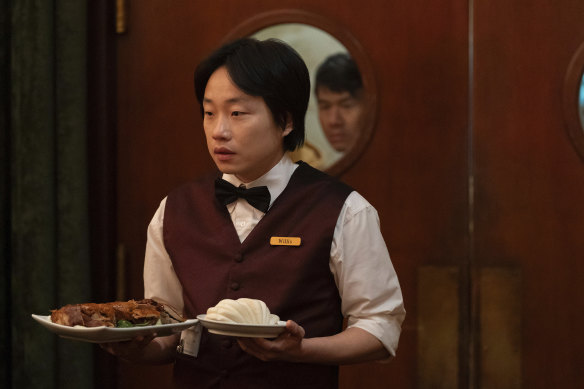
Interior Chinatown
★★★★
Disney+
This 10-part series is an ambitious adaptation of Charles Yu’s 2020 novel of the same name, which took a scathing swipe at Asian representation and stereotypes in Western pop culture.
The story follows Willis Wu (the always funny Hong Long-American comedian Jimmy O Yang, best known for Silicon Valley), a waiter at his uncle’s Chinese restaurant, The Golden Palace, who is unsatisfied with his lot; he’s tired of feeling like a “background character in someone else’s story” and would like instead to be a main protagonist. He spends his days taking orders, taking out the rubbish and playing the restaurant’s video game with his misanthropic colleague Fatty, (Ronnie Chieng). When he’s not working, Willis tries to console his parents, both grieving Willis’s kung-fu prodigy brother (Chris Pang) , who went missing 12 years earlier.

Jimmy O Yang, who wants to be more than a “background character”.Credit: AP
So far, so straightforward. But it soon transpires that Willis’ feelings of being a minor player are not merely figurative – he actually is a bit player inside a cheesy police procedural called Black & White: Impossible Crimes Unit (clearly a piss-take of cop shows such as Law & Order), which stars two cops – a blonde white woman (Lisa Gilroy) and a black man (Sullivan Jones) – who always solve their cases, and spend a lot of time exchanging significant glances, staring into the distance and walking briskly away from crime scenes.
It takes a minute, but you quickly realise that things quickly have taken a meta turn, as Willis (like the viewer), realises what’s happening. When the lighting and the music changes, and detectives appear, the action is “inside” the cop show. Yu, whose original book was written in screenplay format (hence the title) is the showrunner here and Taika Waititi is the executive producer, and directs the first episode. The series has a distinctively Waititi whimsy about it.

Ronny Chieng and Jimmy O Yang.Credit: AP
When Willis witnesses an attempted kidnapping outside the Golden Palace, and another detective, Lana Lee (Chloe Bennet), a Korean woman tasked with the Chinatown beat (of course), comes to the restaurant to investigate, he sees his chance to move from Generic Asian Man to possible hero of the story. (Willis’ ultimate goal though, is to be Kung Fu Guy, and there actually are some brilliant kung-fu action scenes in the mix here; even Ronnie Chieng gets involved.)
Once Willis teams up with Lana Lee to help with the kidnapping case, he discovers that his missing brother might also be involved, and a secondary investigation starts to unfold inside the meta-narrative.
It sounds confusing, but once you buy into the concept – signified by cleverly integrated background scores, lighting and camera angles – it’s a bonkers, fun ride. Less scathing in its commentary on race than his original book, Yu’s adaptation still lampoons Hollywood’s tokenistic portrayal of minorities.









 Add Category
Add Category